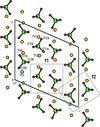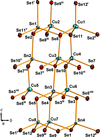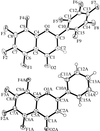issue contents
May 2010 issue

Cover illustration: Two-dimensional isostructurality among polymorphs of benzene-1,2-diamine, showing (top) the crystal packing in one polymorph, viewed down the a axis, and (bottom) the crystal packing in a second polymorph, viewed down the b axis. Hydrogen bonds are shown as dotted lines. See Czapik & Gdaniec [Acta Cryst. (2010), C66, o198-o201].
inorganic compounds
Download citation


Download citation


The title structure is a new modification of Tl2CrO4. It is closely related to the already known modification which belongs to the β-K2SO4 family, but it differs in the number of independent cations and anions: there are four independent Tl+ cations and two [CrO4]2− anions in the title structure, in contrast with the β-K2SO4 family where there are two independent cations and one anion.
Download citation


Download citation


The structure of the title compound, in the space group F23, is related to a cubic perovskite, with isolated RuO6 octahedra and distorted O polyhedra around Al. The La and Sr atoms share the same sites.
Download citation


Download citation


The monoclinic structure (C2/c) of the title compound is built up from layers of PO4 and ZnO4 vertex-sharing tetrahedra parallel to the bc plane with interlayer ZnO2(N/O)2 tetrahedra. Neighbouring layers are linked via Zn—O—P bridges. Hydrogen bonding and weaker electrostatic contacts are present between adjacent ZnO2(N/O)2 tetrahedra and between these tetrahedra and the layers parallel to the bc plane.
Download citation


Download citation


The Cu2Se3Sn structure investigated in this paper is a superstructure of the cubic and monoclinic modifications reported earlier. The eight independent Cu atoms and four independent Sn atoms occupy, respectively, one-third and one-sixth of the tetrahedral holes in a pseudo-close-packed Se lattice. The cation positions are fully ordered.
metal-organic compounds
Download citation


Download citation


Download citation


Download citation


Download citation


Download citation


Download citation


Download citation


Download citation


Download citation


organic compounds
Download citation


Download citation


Download citation


Download citation


Download citation


Download citation


Download citation


Download citation


Download citation


Download citation


Download citation


Download citation




 journal menu
journal menu
































